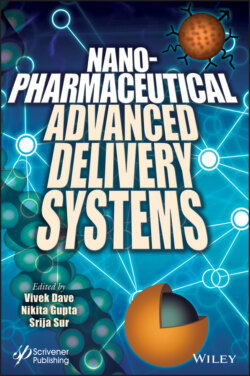Читать книгу Nanopharmaceutical Advanced Delivery Systems - Группа авторов - Страница 17
1.3 Types of Nanocarriers 1.3.1 Liposomes
ОглавлениеThe most popular and well-researched nanocarriers are liposomes, which are synthetic phospholipid vesicles with a size of about 50–1,000 nm that can be loaded with a variety of drugs including hydrophilic and hydrophobic drugs. Figure 1.1 depicts it all [19]. Originally liposomes referred to as smectic mesophase are monolamellar or multilamellar spherical vesicles that include phospholipids either of animal or plant origin. Liposomes were first discovered by AD Bangham and later on described by Allison and Gregoriad [20, 21]. Liposomes are spherical vesicles composed of bilayer lipids. They can encapsulate hydrophilic drugs within bilayer lipids due to their unique structure, and in the central aqueous core, hydrophilic agents typically protect the agents against degradation. Liposomes promote pharmacokinetics of loaded pharmaceutical active agents and provide higher loading efficacy, higher biological stability, controlled release, biological compatibility, and many others; the basic structural components of liposomes, i.e., phospholipids, are amphiphilic in nature [22]. These amphiphilic lipids get dissolved with an aqueous medium, and liposomes were aggregated by increased process entropy over certain concentration [23, 24]. In early days, liposomes were described as not containing surface modifiers, but later they were modified to differ in rigidity, size, and other properties by altering the composition of the lipid [25]. The next-generation liposomes were offered with molecular targeting capabilities through the attachment of unique ligands to their surface [26]. In addition, different ligands and functional molecules are easy to incorporate, thereby offering practical applications for the delivery of labile drugs and genetic materials. Liposomes also suffer from certain drawback, like other carrier systems. The development costs and all other aspects should be considered while developing a formulation to enhance drug therapeutic efficacy. The uses of sophisticated explants and tedious manufacturing process increase the cost of production of liposomes [27, 28].
Figure 1.1 Types of liposomes. (a) Unilamellar vesicle, (b) multilamellar vesicle, (c) immunoliposome, and (d) stealth liposomes.
